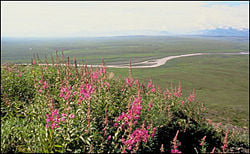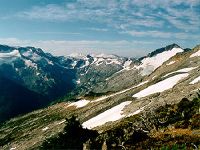Difference between revisions of "Tundra" - New World Encyclopedia
Rick Swarts (talk | contribs) (Replaced the Wikipedia image of swastika caused by vandalism there) |
|||
| Line 1: | Line 1: | ||
| + | {{Contracted}} | ||
In physical [[geography]], '''tundra''' is an area where the [[tree]] growth is hindered by low temperatures and short growing seasons. The term "tundra" comes from [[Kildin Sami]] ''tū̄ndra'', the [[genitive]] of ''tundar'', "treeless plain". | In physical [[geography]], '''tundra''' is an area where the [[tree]] growth is hindered by low temperatures and short growing seasons. The term "tundra" comes from [[Kildin Sami]] ''tū̄ndra'', the [[genitive]] of ''tundar'', "treeless plain". | ||
Revision as of 22:15, 10 May 2006
In physical geography, tundra is an area where the tree growth is hindered by low temperatures and short growing seasons. The term "tundra" comes from Kildin Sami tū̄ndra, the genitive of tundar, "treeless plain".
There are three types of tundra: Arctic tundra, Antarctic tundra, and alpine tundra. In all of these types, the dominant vegetation is grasses, mosses, and lichens.
Trees grow in some of the tundra. The ecotone (or ecological boundary region) between the tundra and the forest is known as the tree-line or timberline.
See also: Fellfields
Arctic tundra
Arctic tundra occurs in the far Northern Hemisphere, north of the taiga belt. The word "tundra" usually refers only to the areas where the subsoil is permafrost, which contains permanently frozen water. (It may also refer to the treeless plain in general, so that northern Lapland would be included.) Permafrost tundra includes vast areas of northern Russia and Canada [1]. The arctic tundra is home to several peoples who are mostly nomadic reindeer herders, such as the Nganasan and Nenets in the permafrost area (and the Sami in Lapland).
The biodiversity of tundra is low. There are few species with large populations. Notable animals in the arctic tundra include caribou (reindeer), musk ox, lemmings, and polar bears (only the extreme north) (Blue Planet Biomes 2006).
Due to the harsh climate of the arctic tundra, regions of this kind have seen little human activity, even though they are sometimes rich in natural resources such as oil and uranium. In recent times this has begun to change in Alaska, Russia, and some other parts of the world.
Global warming is a potential threat to the arctic tundra because of the permafrost. Permafrost is essentially a frozen bog; in the summer, only its surface layer melts. The melting of the permafrost in a given area on human time scales (decades or centuries) could radically change which species would survive there (Climate Change Impacts:A Changing World?|work=Impacts of Climate Change 2006).
Another concern is that about one third of the world's soil-bound carbon is in taiga and tundra areas. When the permafrost melts, it releases carbon, in the form of carbon dioxide, a greenhouse gas. The effect has been observed in Alaska. In the 1970s, the tundra was a carbon sink, but today, it is a carbon source (W. C. Oechel et al 1993). |
Antarctic tundra
Antarctic tundra occurs on Antarctica and on several antarctic and subantarctic islands, including South Georgia and the South Sandwich Islands and the Kerguelen Islands. Antarctica is mostly too cold and dry to support vegetation, and most of the continent is covered by ice fields. However, some portions of the continent, particularly the Antarctic Peninsula, have areas of rocky soil that support tundra. Its flora presently consists of around 300-400 lichens, 100 mosses, 25 liverworts, around 700 terrestrial and aquatic algae species, which live on the areas of exposed rock and soil around the shore of the continent. Antarctica's two flowering plant species, the Antarctic hair grass (Deschampsia antarctica) and Antarctic pearlwort (Colobanthus quitensis), are found on the northern and western parts of the Antarctic Peninsula[2]
In contrast with the arctic tundra, the Antarctic tundra lacks a large mammal fauna, mostly due to its physical isolation from the other continents. Sea mammals and sea birds, including seals, penguins, inhabit areas near the shore, and some small mammals, like rabbits and cats, have been introduced by humans to some of the subantarctic islands.
The flora and fauna of Antarctica and the Antarctic Islands (south of 60º south latitude) are protected by the Antarctic Treaty[3]
Alpine tundra
Alpine tundra occurs at high enough altitude at any latitude on Earth. Alpine tundra also lacks trees, but does not usually have permafrost, and alpine soils are generally better drained than permafrost soils. Alpine tundra transitions to subalpine forests below the tree-line; stunted forests occurring at the forest-tundra ecotone are known as Krummholz.
Notable animals in the alpine tundra include, Kea parrots, marmots, Mountain goats, and pika.
Alpine tundra does not map directly to specific WWF ecoregions. Portions of Montane grasslands and shrublands ecoregions include alpine tundra.
See also: Alpine climate
ReferencesISBN links support NWE through referral fees
- The Tundra Biome. The World's Biomes. URL accessed on 2006-03-05.
- Tundra. Blue Planet Biomes. URL accessed on 2006-03-05.
- Climate Change Impacts:A Changing World?. Impacts of Climate Change. URL accessed on 2006-03-05.
- W. C. Oechel et al (11 February 1993). "Recent change of Arctic tundra ecosystems from a net carbon dioxide sink to a source". Nature 361: 520-523.
- Terrestrial Plants. British Antarctic Survey: About Antarctica. URL accessed on 2006-03-05.
- Protocol on Environmental Protection to the Antarctic Treaty. British Antarctic Survey: About Antarctica. URL accessed on 2006-03-05.
External links
- Tundra biome information from the University of California
- WWF Tundra Ecoregions
- The Arctic biome at Classroom of the Future
Credits
New World Encyclopedia writers and editors rewrote and completed the Wikipedia article in accordance with New World Encyclopedia standards. This article abides by terms of the Creative Commons CC-by-sa 3.0 License (CC-by-sa), which may be used and disseminated with proper attribution. Credit is due under the terms of this license that can reference both the New World Encyclopedia contributors and the selfless volunteer contributors of the Wikimedia Foundation. To cite this article click here for a list of acceptable citing formats.The history of earlier contributions by wikipedians is accessible to researchers here:
The history of this article since it was imported to New World Encyclopedia:
Note: Some restrictions may apply to use of individual images which are separately licensed.
- ↑ The Tundra Biome. The World's Biomes. Retrieved 2006-03-05.
- ↑ Terrestrial Plants. British Antarctic Survey: About Antarctica. Retrieved 2006-03-05.
- ↑ Protocol on Environmental Protection to the Antarctic Treaty. British Antarctic Survey: About Antarctica. Retrieved 2006-03-05.

